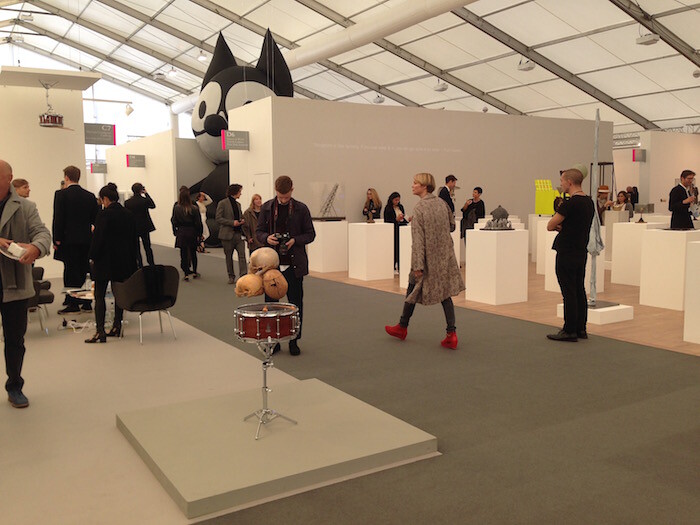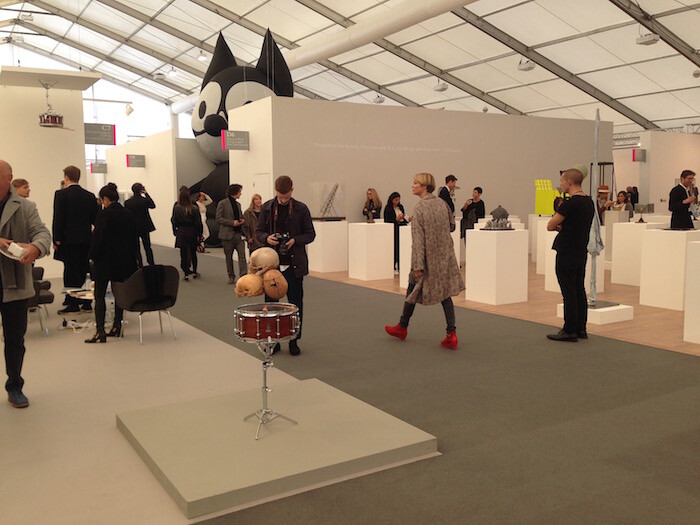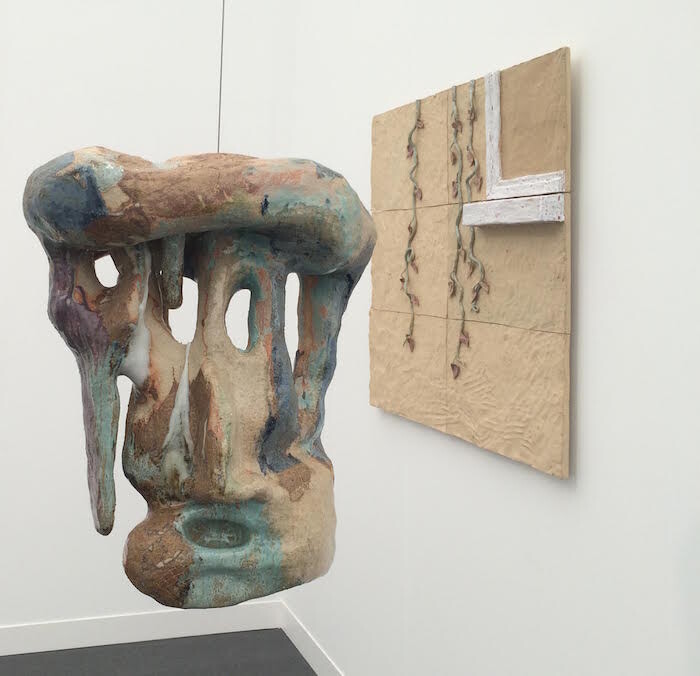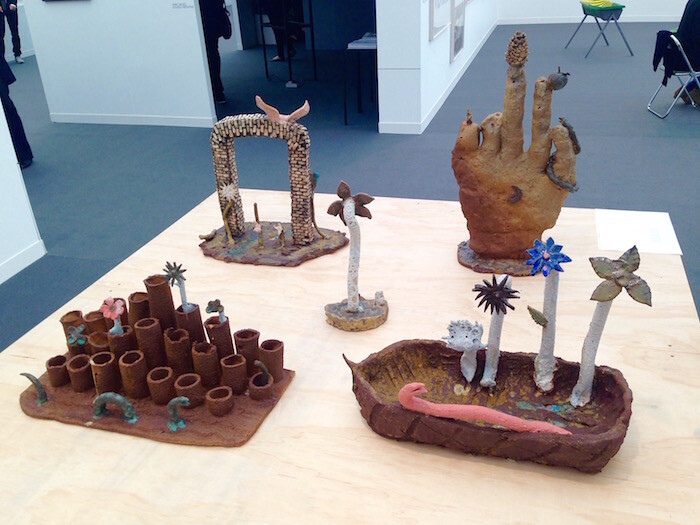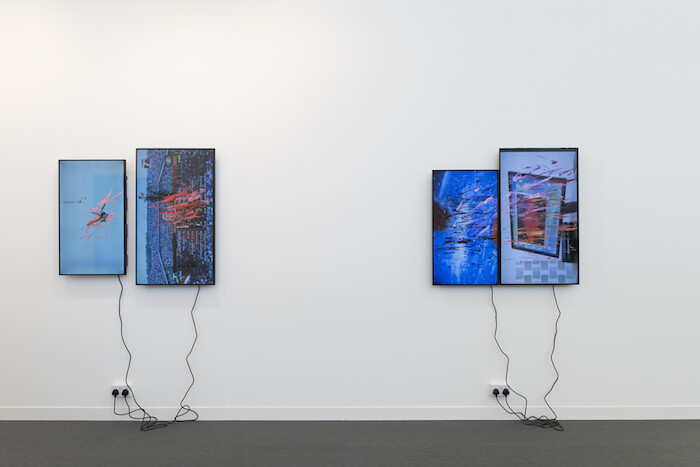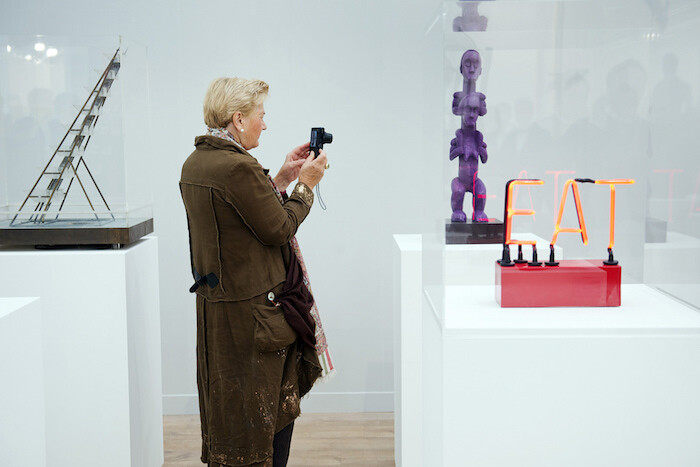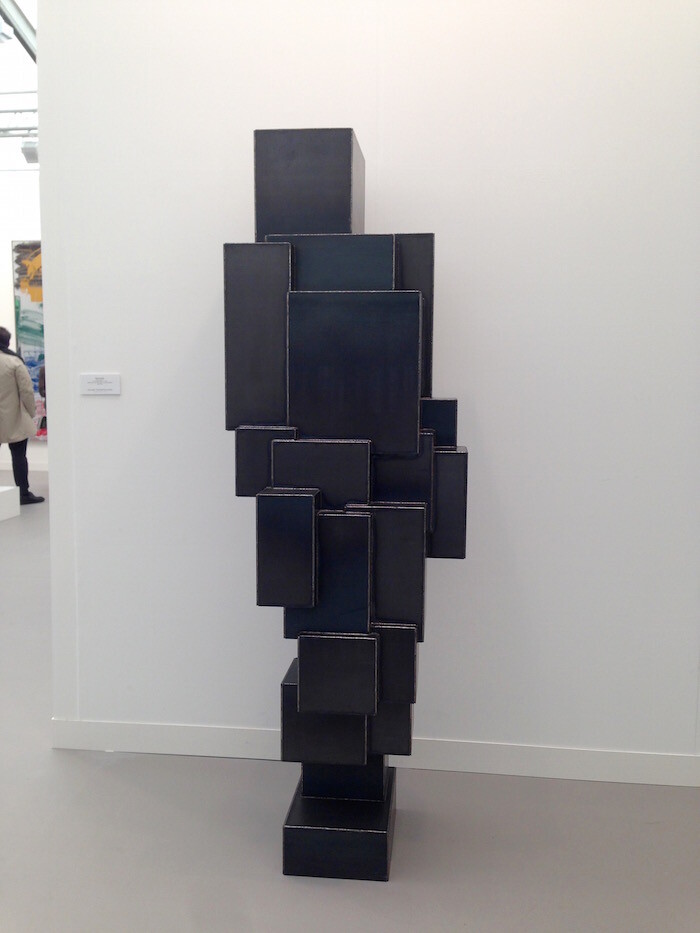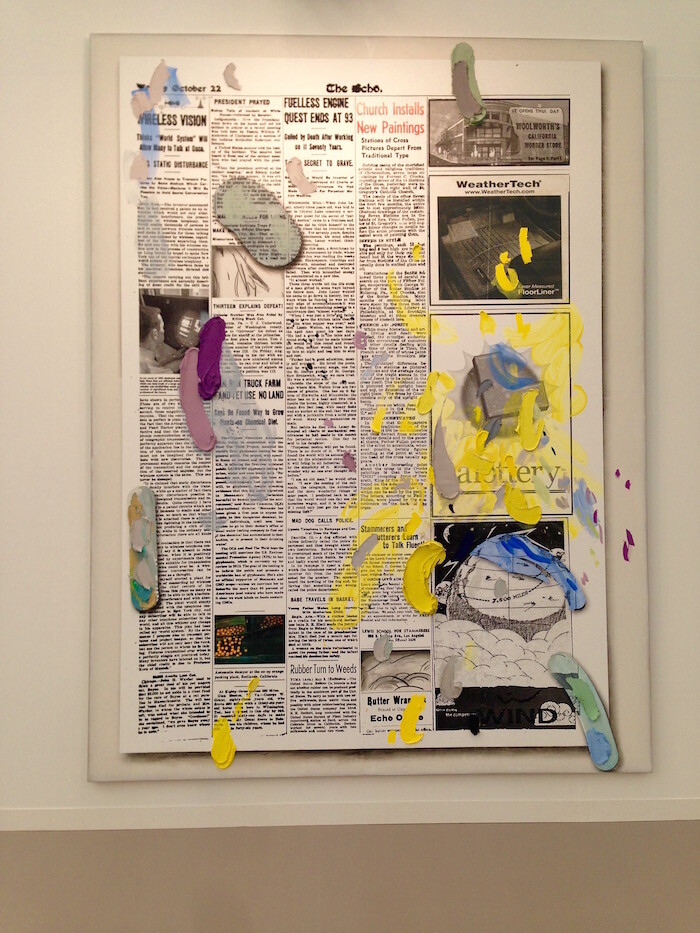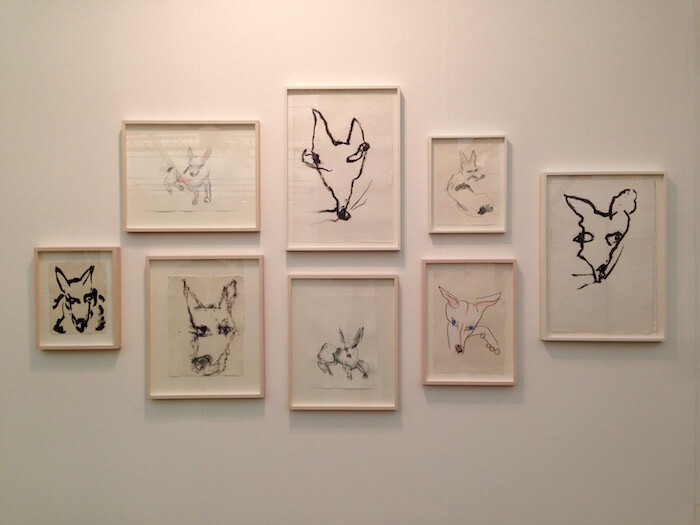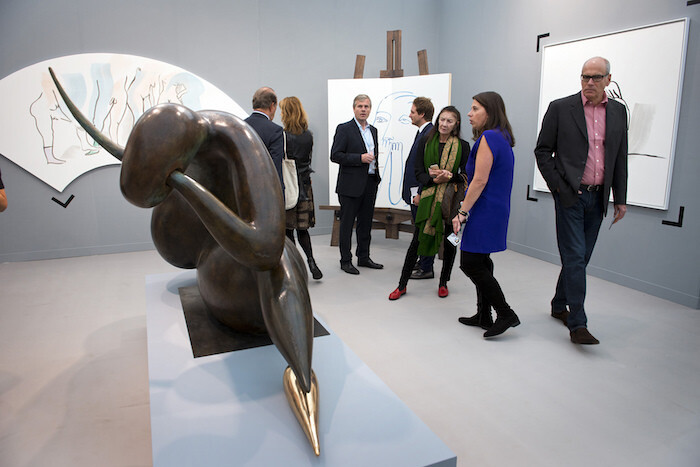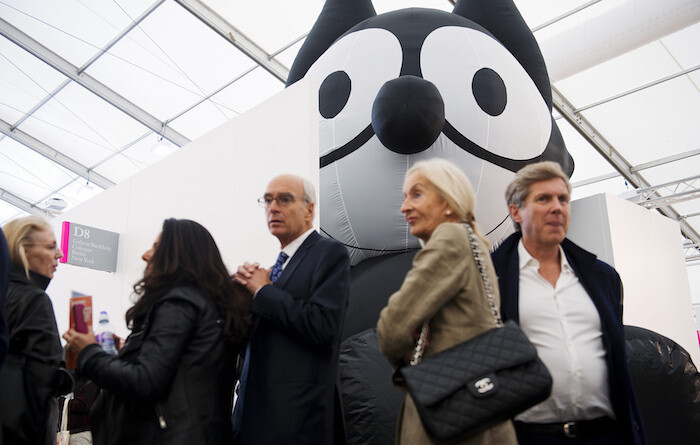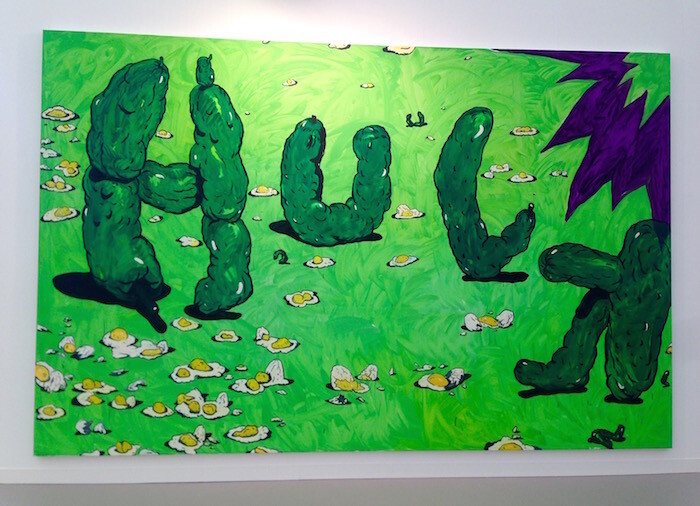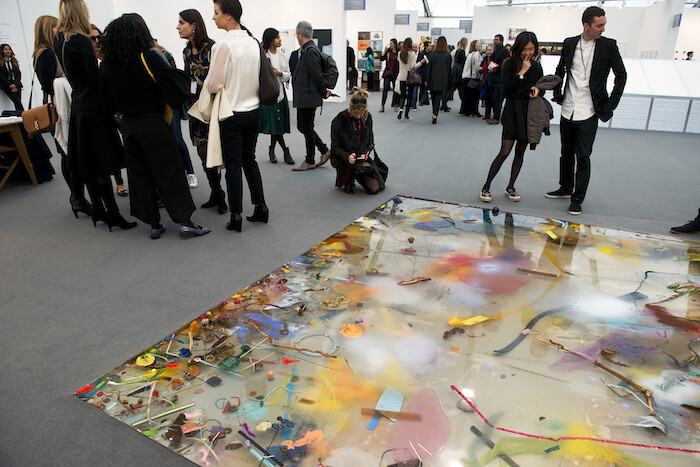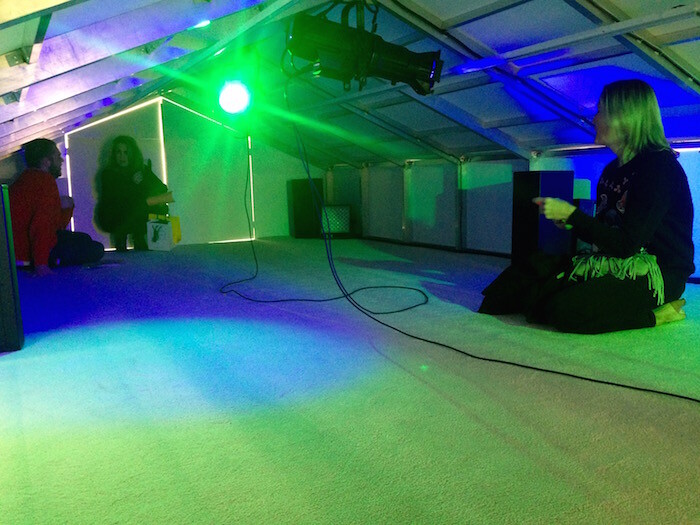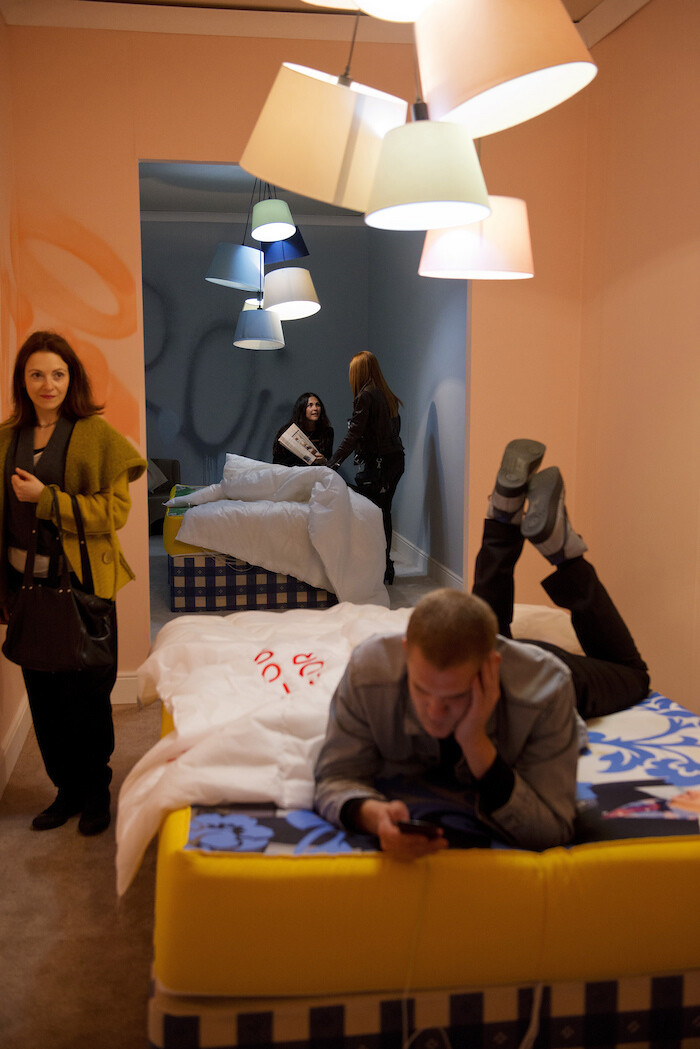October 14–17, 2015
Sociologists have a name for the acute disorientation that half an hour at Frieze London can induce: the “Gruen effect.” Named after Victor Gruen, the Austrian émigré who designed America’s first malls in the 1950s, it describes the sense of temporal and geographical dislocation that sets in when you enter a shopping center. Thrust into a windowless, self-contained space, surrounded by complex arrangements of enticing objects under artificial lights, you begin to lose track of where you are. This is true of Frieze, the layout of which is so complex, and so repetitive, that it is impossible not to get lost however many times you consult the map.
With its bewildering multitude of booths housed under a vast peaked tent, the fair’s main space is a warren of boutiques presenting potential buyers with archly conceptual canvases (Michael Krebber at Maureen Paley, London), playful ceramic sculptures (Jesse Wine at Limoncello Gallery, London; Aaron Angell at Rob Tufnell, also London), LCD screens defaced with graffiti-like smears of oil paint (Ken Okiishi at London’s Pilar Corrias), and a parodic corporate salesroom pitch for a fictional resort (Villagio [2015] by Rancourt/Yatsuk, performed in the auditorium as part of Frieze Live). Frieze offers an astonishing diversity of work, from garish Pop Art sculptures to enigmatic video pieces, all of it brightly lit, vibrantly displayed, and jostling for attention. The experience of encountering so many individual works has an ironic effect: they blur into a homogenized mass of sensation through which the visitor drifts, like a latter-day flâneur, lost and increasingly numb.
In keeping with a display strategy often associated with Frieze, established artists are hung on temporary walls or dolloped on gray carpet while suited sales reps huddle round laptops at nearby tables, jealously guarding stacks of high-spec business cards. In order to stand out from the crowd, certain galleries have jettisoned this white cube model in favour of a more considered approach. Hauser & Wirth is among the more successful examples at this year’s fair. Their precisely curated space is a grid of plinths on which are perched a diverse array of small, often beautiful works by a staggering number of well-known artists: Martin Creed, Subodh Gupta, Pipilotti Rist, Phyllida Barlow, Louise Bourgeois, Mark Wallinger, and Paul McCarthy, to name a few. The sculptures include a Perspex container housing prickly cacti, an upside-down teddy bear with a designer lamp stuck in its rectum, an inscrutable cast-metal replica of a cardboard box, and a chessboard covered with pebbles. The precision of this arrangement, which recalls the austere display strategies of a public museum, makes for an engaging booth in which unrelated works are brought into nuanced conversation with one another.
The same cannot be said of all the galleries in the first two sections of the tent. (Frieze is organized in such a way that the biggest, most conservative galleries are the first you encounter; the younger galleries are tucked away in smaller booths at the tent’s farthest end, despite containing much of the most interesting work on display.) Many of these blue-chip booths—Lisson, David Zwirner, Vitoria Miro, and so on—appear to be conspiring with one another to instill a sense of déjà vu in the fair’s visitors. Now and then you begin to wonder if you have inadvertently doubled back on yourself. Antony Gormley’s Fall II (2014), at Paris’s Galerie Thaddaeus Ropac, is an assemblage of welded steel boxes vaguely resembling a human body—but didn’t you see it just a second ago, and wasn’t it slightly smaller? No, that was another work by the same artist: Corner IV (also 2014), virtually identical to Fall II in all but height, squatting in the corner of White Cube’s booth. In Laura Owens’s Untitled (2015), a huge canvas hung on the outer wall of Sadie Coles HQ, London, the artist has daubed bright splotches of acrylic and oil on an oversized silkscreen reproduction of a newspaper. Is the work a reference to two remarkably similar silkscreen paintings by Allen Ruppersberg in London’s greengrassi gallery’s adjacent booth (The Human Figure and Art, both 1982), or is the echo coincidental? Booth logic begins to break down. As time goes on, it becomes increasingly difficult to distinguish one gallery space from another. But getting lost can have its pleasures.
One of these is discovering unexpected connections between artists, flukes of correspondence that, given the nature of the fair, cannot have been orchestrated. In Untitled (2003), a framed series of charcoal-and-pencil drawings displayed on one wall of London’s Wilkinson Gallery’s booth, Joan Jonas has drawn and redrawn the same creature several times: a fox with sly, menacing eyes and ears resembling devils’ horns. The pieces, which evoke Trickster deities and Jungian archetypes with a series of gestural, loose-wristed marks, bring to mind a similar drawing shown as part of The Pale Fox, Camille Henrot’s 2014 solo show at London’s Chisenhale Gallery. It is gratifying, therefore, to encounter Paris’s Galerie Kamel Mennour’s booth, which is devoted entirely to new works by Henrot, a short while later. In Minor Concerns (2015), a series of large-scale watercolors, the artist explores the humor and shame attendant in domestic routine using elegant swipes and squiggles reminiscent of Jonas’s foxes. Henrot’s male and female characters masturbate over MacBooks, trip on beer cans, and wring water from their hair: the kinds of quotidian goings-on that usually take place behind closed doors. Frieze is predictably studded with overblown, cartoonish, eye-grabbing works (examples include Inflatable Felix [2014], a giant inflatable model of Felix the Cat by Mark Leckey, and Hulk 2 [2015], a lurid green painting by Armen Eloyan), but it’s the quieter pieces, among them Henrot’s and Jonas’s, that leave the most lasting impression.
Kamel Mennour isn’t the only gallery to have given their space to a single artist. In a fair as crowded as Frieze, this approach—in contradistinction to Hauser & Wirth’s marshaling of dozens of big names—is a canny strategy for focusing itinerant visitors’ attention. London’s Stephen Friedman Gallery’s booth is given over to Cocktail Party (2015) by Tom Friedman: an installation of life-size sculptures featuring hipsters, dilettantes, iPhone obsessives, and rich folk in blazers, high-heels, and handbags—a mirror image of the Frieze demographic. Elsewhere, Gagosian Gallery has produced a lavish booklet to accompany their solo exhibition of drawings and sculptures by Glenn Brown. The works display the artist’s trademark deliquescent aesthetic, originally developed in his highly polished oil paintings, in which bodies and objects are evoked using rippling, shivering lines, making them seem forever on the verge of melting. Gagosian have clearly thrown a lot of money into anointing Brown as a serious artist but the work itself, though eminently sellable, is underwhelming.
For less established galleries, art fairs can be as much about making an impression as making a sale, and London-based The Sunday Painter—showing at Frieze for the first time—has boldly decided to showcase not just a single artist, but a single artwork. Lonely Planet 2 (2015), by Samara Scott, is a rectangular basin set into the floor and filled with consumer detritus: belts, spring onions, plastic jewelry, strips of tape and foam, pebbles, twigs, ribbons, and plastic cups, all submerged beneath clear water atop which islands of oil, food dye, and spray paint float. This puddle of brightly colored, disposable stuff is—perhaps surprisingly given its ad hoc nature—one of the most visually stimulating pieces in the fair. After 6 p.m., once the complimentary bottles of Pommery champagne start doing the rounds, an assistant erects a metal wire to prevent visitors from staggering into the artwork.
Across the way from The Sunday Painter is a white scale replica of the Frieze London tent (Untitled, 2015) by New York-based artist Rachel Rose, the winner of this year’s Frieze Artist Award. It is one of seven Frieze Projects: a commissioned series of works, shown in and around the booths, designed to boost the fair’s critical profile. I have to duck and crawl to enter Rose’s installation through a small door, as if enacting a scene from Alice in Wonderland. After awkwardly hobbling on bent knees past hanging light fittings, speakers emitting soothing lounge music, and other visitors’ outstretched legs, I lie down flat on the soft carpet and close my eyes. The work’s soundscape, which features music and muffled sound effects, mimics the experience of the wild animals who live in Regent’s Park, beneath and around the fair. Like another Frieze Project by the art collective ÅYR (formerly Airbnb Pavilion)—a Comfort Zone (2015) featuring a long sequence of pastel-hued rooms equipped with double beds on which visitors can sprawl, recharge their phones, and contemplate the mood lighting—Rose’s piece provides a welcome haven of sensory calm in the midst of a fair that lives up to its reputation for excess.
